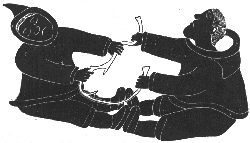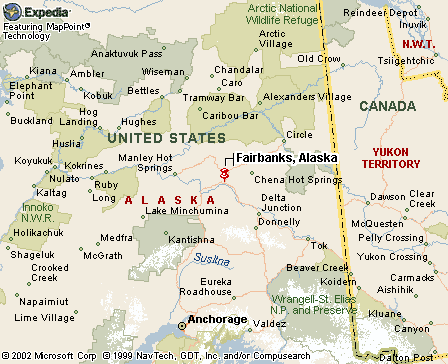|
|
Canku Ota |
|
|
(Many Paths) |
||
|
An Online Newsletter Celebrating Native America |
||
|
July 27, 2002 - Issue 66 |
||
|
|
||
|
At Native Games, Tradition Means Everything |
||
|
by Beth Bragg Anchorage
Daily News
|
||
|
credits: 1966 stone
cut by Akourak of stick pull
|
 Fairbanks,
AK - Like any world champion, Eli Kagak of Barrow prepares himself for
big competitions. Fairbanks,
AK - Like any world champion, Eli Kagak of Barrow prepares himself for
big competitions.
Training for the World Eskimo-Indian Olympics, however, isn't like training for a bike race or a football game. Instead of weight rooms and stopwatches, an athlete like Kagak uses walruses and seals. Kagak, 27, won his fifth championship in the Eskimo stick pull Thursday at the Big Dipper Arena. The event is a tug of war between two opponents who sit on the floor across from each other, their legs extended and their hands gripped around a rounded wooden stick about a yard long. It's a contest of brute strength, an attribute Kagak relied on last week while hunting in the waters northwest of Barrow on Alaska's northern coast. "The day before I came here, me and some friends got two walruses and two bearded seals," Kagak said. "The bearded seals, you have to pull them out of the water and put them in the boat. The walruses we cut up on the ice, and after we get them cut up, we pull them into the boat. "That's where we pull." And that is the secret to his success at the World Eskimo-Indian Olympics. Holly Gould-Grady of Anchorage won the women's Indian stick pull -- another tug-of-war, only the stick is shorter and greased with shortening. She credited her ancestry with providing the skills necessary to prevail in her slippery sport. "I grew up on the Aleutian chain, and we used to catch fish with our bare hands for fun," she said. And if you can hold onto a wriggling salmon, you probably can hold onto a greasy stick. That, after all, is the point of the Indian stick pull. The spirit of WEIO is embodied by people like Kagak, an Inupiaq Eskimo, and Gould-Grady, who describes herself as an Aleut-Athabaskan-Irish-Norwegian. The games were created in 1961 as a way to preserve age-old contests of skill, strength, agility and endurance, many of which imitate the abilities needed to live in the Arctic. Some competitors hone their skills in ways less traditional than catching fish barehanded or pulling 300-pound bearded seals into a boat. "The last couple of weeks I've been shoveling gravel in the driveway," said Benita Katairoak of Barrow, winner of the women's Eskimo stick pull. Kagak and Katairoak claimed titles in a sport that rewards strength and size. The object of the Eskimo stick pull is either to pull the stick out of the other person's hands or pull the entire person off the floor and into your lap. Kagak weighs 400 pounds. He is similar in size, and is trying to become similar in stature, to Barrow's Big Bob Aiken, who won a record eight Eskimo stick pull championships (1982-89). Over the years, few men have managed to pull the stick from Kagak or Aiken, much less pull either into their lap. Lest you think Kagak is a one-trick draught horse, consider that he claimed third place in the Indian stick pull. Size isn't everything in this event. A tight grip on the greased stick is necessary, and it helps if you also can pull quickly without jerking the stick. In both stick pulls, jerking and twisting are not allowed. John Miller, a slender 14-year-old from Barrow, surprised just about everyone -- himself included -- by winning the men's Indian stick pull. Miller faced Kagak in the winner's bracket semifinal and won both pulls in the best-of-3 competition. Even so, he sounded reverential as he talked about Kagak. "That guy has a huge grip, man," Miller said. "I seen him, and he scared me." In the finals, Miller again needed only two pulls to beat Cory Katairoak of Barrow. It was Miller's first WEIO championship. "I didn't think I'd do any good. It's the first time I'd done it," he said. "Big Bob showed me how to grip it, so that kind of helped me out." It's hard to imagine a messier sport than the Indian stick pull. Between every pull, a new coat of grease is spread on the stick. Participants go through so many paper towels -- three rolls were needed for the women's competition -- that Bounty should become a WEIO sponsor. But it could be worse, said Gould-Grady, 24, who wiped grease off her hands as she discussed the differences between the Indian stick pull and barehanded fishing. In fishing, you're rewarded with savory, fresh salmon. But in the stick pull, she said, "you don't have that slimy smell."
|
|
|
||
|
|
||
| Canku Ota is a free Newsletter celebrating Native America, its traditions and accomplishments . We do not provide subscriber or visitor names to anyone. Some articles presented in Canku Ota may contain copyright material. We have received appropriate permissions for republishing any articles. Material appearing here is distributed without profit or monetary gain to those who have expressed an interest. This is in accordance with Title 17 U.S.C. section 107. | ||
|
Canku Ota is a copyright © 2000, 2001, 2002 of Vicki Lockard and Paul Barry. |
||
 |
 |
|
|
The "Canku Ota - A Newsletter Celebrating Native America" web site and its design is the |
||
|
Copyright © 1999, 2000, 2001, 2002 of Paul C. Barry. |
||
|
All Rights Reserved. |
||
